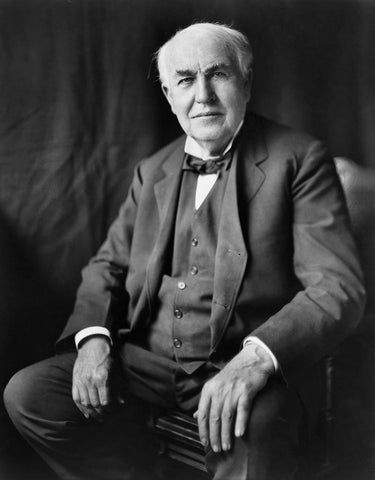Following the First World War, spiritualism and the study of the afterlife saw a surge in popularity as desperate families searched for ways to hold onto those taken from them. The war had left people with a sense of uncertainty and a fear of the future. It made sense that many turned to those who claimed they could reach a world beyond— and even make contact with the loved ones they had lost. Mediums and mystics emerged at all corners of society, offering to commune with the deceased. For a price, of course.
Amongst those attempting this contact with those no longer living, emerged a man of science, someone you might’ve not expected to be associated with the study of the afterlife. Phonographs and lightbulbs sure… but what in the world did Thomas Edison have to do with the dead?

Born in 1847, Thomas Edison was an American Inventor whose inventions and patents played an important role in bringing about the modern age of electricity. The first thing that likely comes to mind when thinking about Edison is the incandescent light bulb (in this case a literal light bulb and not just a symbolic one, signalling that you’ve had an idea).
While the light bulb is certainly amongst Edison’s most famous inventions, it’s documented that he had published over one thousand patents. His belief in challenging the impossible was at the centre of each new discovery. From the phonograph to the kinetograph (an early movie camera), Edison’s ideas often revolved around the fields of electricity and telegraphy, creating new and innovative tools for the living.
But there was one invention he spoke about that also aimed to serve the dead.
In an article in The American Magazine dated October 16 1920, Edison spoke at length of a creation that would allow him to speak with those no longer with us. This might’ve been a surprising announcement for people at the time who knew Edison as a man of science. In fact, he openly criticised the work of mediums and their claims that they had made contact with the spirits of the deceased.
“Why should personalities in another existence or sphere waste their time working a little triangular piece of wood over a board with certain lettering on it? Why should such personalities play pranks with a table?” Edison wrote in one of his diaries.
But Edison didn’t see his work as a matter of mysticism and myth. He certainly didn’t consider himself a medium. He continued his pursuit of challenging the impossible through innovation, desiring a more scientific approach to speaking with those already gone.

Photo by Josh Olalde on Unsplash
“I have been at work for some time, building an apparatus to see if it is possible for personalities which have left this earth to communicate with us.”
– Thomas Edison, The American Magazine, 1920
Edison believed that life itself was indestructible, and that all pieces of a person’s life, including their personality and memory, were contained in some sort of physical matter. While invisible to the human eye, Edison believed that if these units of life were able to hold together after death in “swarms” then one of them might be able to find a way to communicate with the living world. They just needed the right tool to do so.
This was the basis for his invention; a machine that would eventually become known as the Spirit Phone.
Edison’s Spirit Phone
Edison sought to create a mechanism that would allow these personality swarms to interact with the material world in some way, something that the microscopic matter could influence or connect to in order to relay their knowledge. You see, Edison believed that these swarms would hold the memory and personality of the deceased, well after their bodies were rotten and decayed. It stands to reason that they could then communicate who they had once been, they just needed a method to do so.
Despite his enthusiasm about surrounding the idea, it’s not actually been confirmed whether or not Edison ever had a chance to bring his device to life. No patent was ever filed. No machine ever documented. But there is one article from Modern Mechanix published decades after Edison’s death that details a secret experiment held in Edison’s old laboratory, a test of his so-called Spirit Phone.
The machine itself is said to have created a pencil thin valve of light that Edison suspected the swarms would be able to interact with and manipulate. According to Modern Mechanix, “tense hours were spent watching the delicate instruments for the slightest indication of a spirit form, but none came.”
While Edison himself may not have been successful in creating a device to connect with the dead, in present day there is an entire industry based around capturing messages of an ethereal nature. The modern day paranormal investigator may come equipped with all sorts of technology– EVP recorders, Spirit Boxes, infrared cameras… but some still prefer the old methods that Edison himself so harshly criticised. Ouija boards included.
Do you think we can receive messages from beyond the grave?
It's not uncommon for the living to try to make contact with other worlds and dimensions. However, some times, it is the unfathomable forces from worlds beyond seek us out themselves; are you brave enough to find out more?
We have partnered with Curious Correspondence to release a brand new product, Doomensions.
We are excited to invite you and your friends to step inside the mystery manor, an eight-room puzzle escape experience to test your guile, wits, and ghost hunting prowess.
We will be launching a Kickstarter on Aug 9th, next Tuesday! If you'd like to be notified of launch, jump over to our page HERE.



